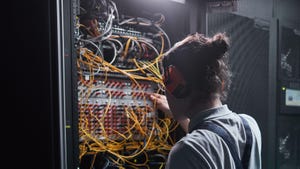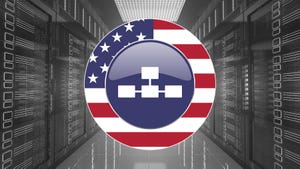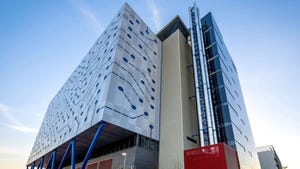Net-Zero AI Data Center Project Gets a $5B Boost in Saudi ArabiaNet-Zero AI Data Center Project Gets a $5B Boost in Saudi Arabia
Saudi Arabia is investing $5 billion in a net-zero AI data center at Neom, designed to run high-performance computing on 100% renewable energy.

Saudi Arabia-based data center developer DataVolt is investing $5 billion in a net-zero AI data center campus to support Neom, the futuristic city at the northern tip of the Red Sea.
Neom is part of Saudi Arabia’s Vision 2030 project, the Kingdom’s broad initiative to diversify its economy and reduce reliance on revenue from fossil fuels. In 2022, Neom announced its first data center project known as ZeroPoint DC.
The latest data center will be built in Oxagon, Neom’s industrial zone on the Red Sea coast. Oxagon will purportedly include access to cost‑competitive renewable energy sources, including green hydrogen, and benefits from subsea fiber connectivity.
“The Kingdom is at the forefront of the global energy transition,” said Vishal Wanchoo, CEO of Oxagon. “At Oxagon, we are accelerating a renewable energy industrial ecosystem that is set to power businesses with green energy and technology solutions.”
Inside the Oxagon Net-Zero AI Data Center
The planned facility at Oxagon is designed to support AI workloads by integrating a variety of computing densities and energy‑efficient architectures.
The facility's target capacity is 1.5 GW, and the power will be supplied entirely from renewable energy sources. As such, the project is set to achieve net‑zero carbon emissions.
The project's implementation will be executed in multiple phases. The first phase, backed by an investment of $5 billion, is scheduled for completion by 2028. This phase will establish the core infrastructure and ensure that the data center is capable of supporting AI and high-performance computing operations.
What’s Driving the Net-Zero Data Center Tend?
The push for net-zero data centers is gaining momentum as AI accelerates demand for capacity and power. A net-zero approach could help mitigate the energy impact, but significant barriers remain.
Multiple data center operators are helping to lead the charge toward net-zero emissions. While AI certainly has an impact, some data center operators, such as Vantage, pledged to lower emissions before the recent AI boom.
“Data center operators are adopting net-zero pledges and the Climate Neutral Data Centre Pact as ambitious and strategic tools to adhere to regulatory pressures to curb energy demand as well as meet global decarbonization goals by 2030 and beyond,” Rithika Thomas, senior analyst at ABI Research, told Data Center Knowledge.
“To realize low carbon operations, operators are adopting advanced cooling solutions, responsible computing, circular IT practices, and leveraging alternative energy sources like green hydrogen.”
Net-Zero is About More Than Just Energy Consumption
While renewable energy sources are a core element of achieving a net-zero position, it is not the only requirement.
Dave Williams, senior principal at PAE Engineers, a sustainable design firm, told Data Center Knowledge that geography plays a crucial role in data center design and construction.
“Looking at specific annual weather data can drive bespoke infrastructure decisions to drive energy-efficient and cost-effective methods in which they are built,” Williams said. “Ensuring that each data center is designed to be the best fit within the environmental region that it resides in is key to lowering overall energy consumption and grid strain.”
Sean Farney, vice president of data center strategy in the Americas at JLL, noted that both evolutionary and revolutionary approaches to sustainability help to achieve net-zero goals.
Farney explained that evolutionary methods include optimizing existing processes, such as raising inlet temperatures, leveraging air-side economization, reducing water usage with advanced cooling techniques, replacing diesel fuel with HVO and adopting condition-based maintenance routines.
On the revolutionary side of the coin, Farney sees the adoption of new energy sources like hydrogen fuel cells and utility-scale batteries to store power from renewables as being impactful.
Read more of the latest data center construction news
Abdullah Choudhry, chief impact officer and co-founder at carbon account platform vendor Arbor, told Data Center Knowledge that building a net-zero data center for AI is a large undertaking, primarily due to the complexity of managing both operational and embodied emissions.
With data centers now consuming around 1-2% of global electricity, Choudhry noted that it’s important to take a holistic view of the sustainability of AI-ready facilities.
Optimizing the amount and source of energy consumption of data centers can still reduce operational emissions, he said. However, embodied emissions are different. These are the greenhouse gases released during the manufacturing, construction, and eventual decommissioning of data center infrastructure – from the steel and concrete in the building to the semiconductors in the servers.
“To truly achieve net-zero, it’s essential to consider the full lifecycle of the data center,” Choudhry said. “This means designing data centers with sustainability in mind: selecting low-carbon materials, adopting designs for easier upgrades, and embracing recycling and reuse strategies to minimize waste.”
Read more about:
Middle East & AfricaAbout the Author
You May Also Like









